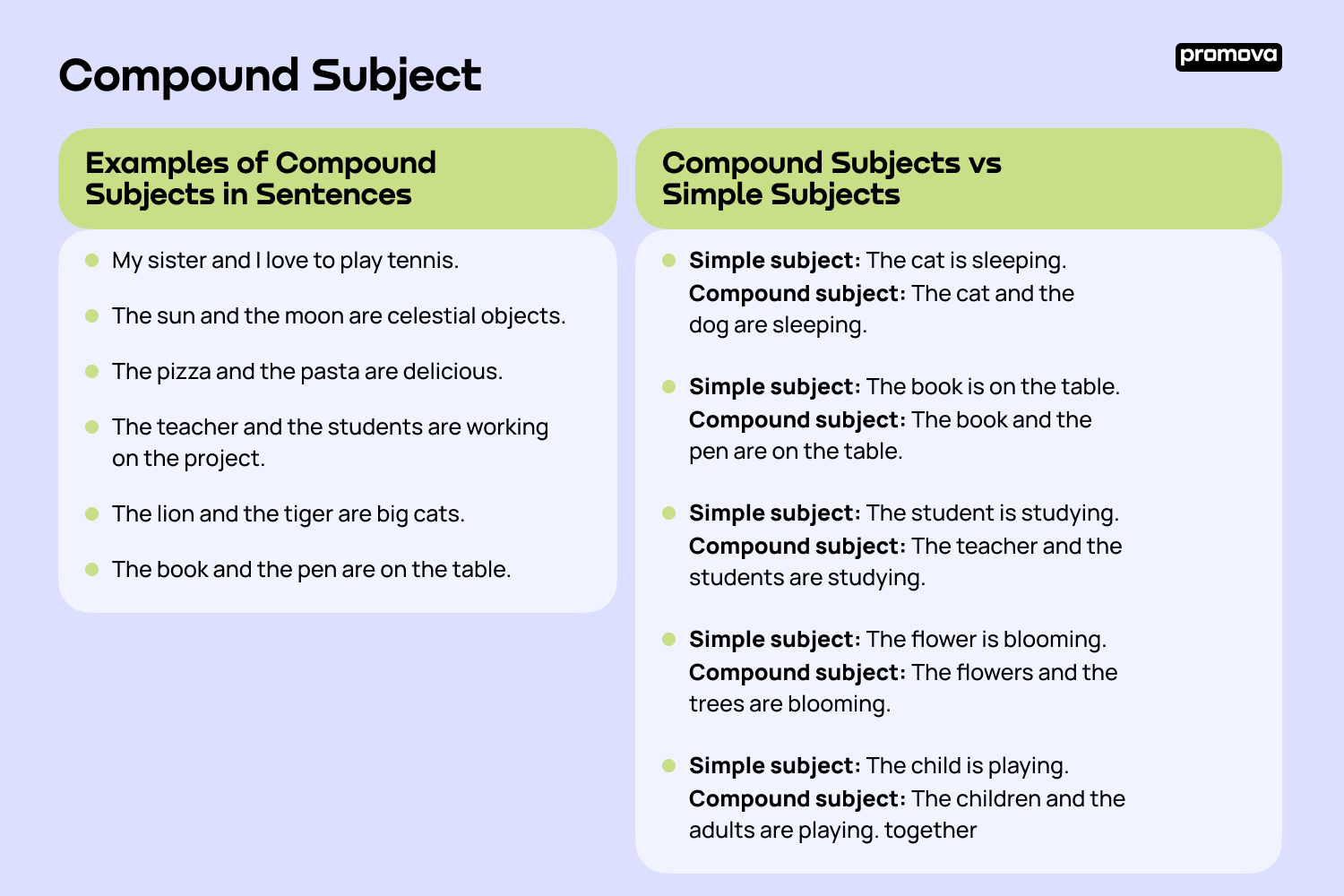Compound Subject
Contents
Do you want to improve your English language skills? If so, understanding compound subjects is vital. A compound subject is a grammatical term that refers to a sentence's subject, which consists of two or more nouns or pronouns. In this reference, we will explore what a compound subject is, its examples, types, and common mistakes. Further, we will compare compound subjects with simple subjects using ten examples.
What is a Compound Subject?
A compound subject refers to a sentence's subject comprising two or more nouns, pronouns, or phrases that share the same verb. The compound subject can either be joined by "and" or "or," depending on the context of the sentence. The primary function of a compound subject is to provide more information about the subject of the sentence.
For instance, in the sentence, "The cat and the dog play together," the subject is a compound subject consisting of two nouns, "the cat" and "the dog." The verb in the sentence is "play," which agrees with the compound subject.

Examples of Compound Subjects in Sentences
Here are some examples of compound subjects in sentences:
- My sister and I love to play tennis.
- The sun and the moon are celestial objects.
- The pizza and the pasta are delicious.
- The teacher and the students are working on the project.
- The lion and the tiger are big cats.
- The book and the pen are on the table.
In each of these sentences, the subject comprises two or more nouns or pronouns, making them compound subjects.
Different Types of Compound Subjects
Compound subjects can be of two types, coordinated and collective. Coordinated compound subjects refer to the sentence's subject, where two or more nouns or pronouns are joined by "and" or "or" to form a plural subject. Collective compound subjects, on the other hand, refer to a group of individuals acting as a single unit.
Here are some examples of both types of compound subjects:
- Coordinated: The musician and the artist are famous.
- Collective: The jury was in a deadlock.
1
How to Identify a Compound Subject
Identifying a compound subject is essential in understanding the sentence's meaning and structure. To identify a compound subject, look for two or more words joined by "and" or "or" in the sentence. The verb in the sentence should agree with the compound subject, indicating that it is a subject.
For example, in the sentence, "The cat and the dog play together," the compound subject is "the cat and the dog," and the verb "play" agrees with the compound subject.
8
Common Mistakes
One common mistake in using compound subjects is to confuse them with simple subjects. A simple subject refers to a sentence's main noun or pronoun, while a compound subject refers to two or more nouns or pronouns in a sentence.
Another common mistake is to use the singular verb form with a compound subject. When using a compound subject, the verb should agree with the subject, meaning if the subject is plural, the verb should be plural.
For example, in the sentence, "The cat and the dog plays together," the verb "plays" does not agree with the compound subject, which is plural.
Compound Subjects vs Simple Subjects
To further understand the difference between compound subjects and simple subjects, here are a few more examples:
- Simple subject: The cat is sleeping. Compound subject: The cat and the dog are sleeping.
- Simple subject: The book is on the table. Compound subject: The book and the pen are on the table.
- Simple subject: The student is studying. Compound subject: The teacher and the students are studying.
- Simple subject: The flower is blooming. Compound subject: The flowers and the trees are blooming.
- Simple subject: The child is playing. Compound subject: The children and the adults are playing. together
Summary
A compound subject is a grammatical term that refers to a sentence's subject comprising two or more nouns, pronouns, or phrases that share the same verb. There are two types of compound subjects, coordinated and collective. To identify a compound subject, look for two or more nouns/pronouns joined by "and" or "or" in the sentence.
If you want to practice your English skills, check out more handy references below!
Comments